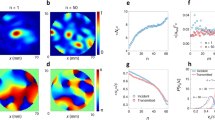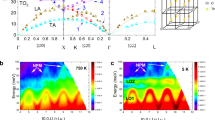Abstract
Excitations in complex media are superpositions of eigenstates that are referred to as ‘levels’ for quantum systems and ‘modes’ for classical waves. Although the Hamiltonian of a complex system may not be known or solvable, Wigner conjectured1 that the statistics of energy level spacings would be the same as for the eigenvalues of large random matrices. This has explained key characteristics of neutron scattering spectra2. Subsequently, Thouless and co-workers argued3,4 that the metal–insulator transition in disordered systems4,5,6 could be described by a single parameter, the ratio of the average width and spacing of electronic energy levels: when this dimensionless ratio falls below unity, conductivity is suppressed by Anderson localization5 of the electronic wavefunction. However, because of spectral congestion due to the overlap of modes7,8,9, even for localized waves, a comprehensive modal description of wave propagation has not been realized. Here we show that the field speckle pattern10 of transmitted radiation—in this case, a microwave field transmitted through randomly packed alumina spheres—can be decomposed into a sum of the patterns of the individual modes of the medium and the central frequency and linewidth of each mode can be found. We find strong correlation between modal field speckle patterns, which leads to destructive interference between modes. This allows us to explain complexities of steady state and pulsed transmission of localized waves and to harmonize wave and particle descriptions of diffusion.
This is a preview of subscription content, access via your institution
Access options
Subscribe to this journal
Receive 51 print issues and online access
$199.00 per year
only $3.90 per issue
Buy this article
- Purchase on Springer Link
- Instant access to full article PDF
Prices may be subject to local taxes which are calculated during checkout





Similar content being viewed by others
References
Wigner, E. P. On a class of analytic functions from the quantum theory of collisions. Ann. Math. 53, 36–67 (1951)
Dyson, F. J. Statistical theory of the energy levels of complex systems. I. J. Math. Phys. 3, 140–156 (1962)
Edwards, J. T. & Thouless, D. J. Numerical studies of localization in disordered systems. J. Phys. Chem. 5, 807–820 (1972)
Thouless, D. J. Maximum metallic resistance in thin wires. Phys. Rev. Lett. 39, 1167–1169 (1977)
Anderson, P. W. Absence of diffusion in certain random lattices. Phys. Rev. 109, 1492–1505 (1958)
Abrahams, E., Anderson, P. W., Licciardello, D. C. & Ramakrishnan, T. V. Scaling theory of localization: absence of quantum diffusion in two dimensions. Phys. Rev. Lett. 42, 673–676 (1979)
Mott, N. F. & Twose, W. D. The theory of impurity conduction. Adv. Phys. 10, 107–163 (1961)
Pendry, J. B. Quasi-extended electron states in strongly disordered systems. J. Phys. Chem. 20, 733–742 (1987)
Bliokh, K., Yu, Bliokh, Yu. P., Freilikher, V., Genack, A. Z. & Sebbah, P. Coupling of localization mode in random media: level repulsion and necklace states. Phys. Rev. Lett. 101, 133901 (2008)
Nye, J. F. & Berry, M. V. Dislocations in wave trains. Proc. R. Soc. Lond. A 336, 165–190 (1974)
Altshuler, B. L. & Shklovskii, B. I. Repulsion of energy levels and conductivity of small metal samples. Sov. Phys. JETP 64, 127–135 (1986)
Berry, M. V. Semiclassical theory of spectral rigidity. Proc. R. Soc. Lond. 400, 229–251 (1985)
Chabanov, A. A., Stoytchev, M. & Genack, A. Z. Statistical signatures of photon localization. Nature 404, 850–853 (2000)
Azbel, M. Eigenstates and properties of random systems in one dimension at zero temperature. Phys. Rev. B 28, 4106–4125 (1983)
Abrahams, E., ed. 50 Years of Anderson Localization (World Scientific, 2010)
Aspect, A. & Inguscio, M. Anderson localization of ultracold atoms. Phys. Today 62, . 30–35 (2009)
John, S. Electromagnetic absorption in a disordered medium near a photon mobility edge. Phys. Rev. Lett. 53, 2169–2172 (1984)
Lagendijk, A. van Tiggelen, B. & Wiersma, D. S. Fifty years of Anderson localization. Phys. Today 62. 24–29 (2009)
Schwartz, T., Bartal, G., Fishman, S. & Segev, M. Transport and Anderson localization in disordered two-dimensional photonic lattices. Nature 446, 52–55 (2007)
Grésillon, S. et al. Experimental observation of localized optical excitations in random metal-dielectric films. Phys. Rev. Lett. 82, 4520–4523 (1999)
Weaver, R. L. Anderson localization of ultrasound. Wave Motion 12, 129–142 (1990)
Hu, H., Strybulevych, A., Page, J. H., Skipetrov, S. E. & Van Tiggelen, B. A. Localization of ultrasound in a three-dimensional elastic network. Nature Phys. 4, 945–948 (2008)
Mello, P. A., Akkermans, E. & Shapiro, B. Macroscopic approach to correlations in the electronic transmission and reflection from disordered conductors. Phys. Rev. Lett. 61, 459–462 (1988)
Feng, S., Kane, C., Lee, P. A. & Stone, A. D. Correlations and fluctuations of coherent wave transmission through disordered media. Phys. Rev. Lett. 61, 834–837 (1988)
Nieuwenhuizen & Van Rossum, M. C. Intensity distribution of waves transmitted through a multiple scattering medium. Phys. Rev. Lett. 74, 2674–2677 (1995)
Kogan, E. & Kaveh, M. Random-matrix-theory approach to the intensity distributions of waves propagating in a random medium. Phys. Rev. B 52, R3813–R3815 (1995)
Stoytchev, M. & Genack, A. Z. Measurement of the probability distribution of total transmission in random waveguides. Phys. Rev. Lett. 79, 309–312 (1997)
Ching, E. S. C., Leung, P. T., Suen, W. M., Tong, S. S. & Young, K. Waves in open systems: eigenfunction expansions. Rev. Mod. Phys. 70, 1545–1554 (1998)
Zhang, Z. Q., Chabanov, A. A., Cheung, S. K., Wong, C. H. & Genack, A. Z. Dynamics of localized waves: pulsed microwave transmissions in quasi-one-dimensional media. Phys. Rev. B 79, 144203 (2009)
Cao, H. et al. Random laser action in semiconductor powder. Phys. Rev. Lett. 82, 2278–2281 (1999)
Golub, G. H. & Pereyre, V. Separable nonlinear least squares: the variable projection method and its applications. Inverse Probl. 19, R1–R26 (2003)
Sima, D. M. & Huffel, S. V. Separable nonlinear least squares fitting with linear bound constraints and its application in magnetic resonance spectroscopy data quantification. J. Comput. Appl. Math. 203, 264–278 (2007)
Cohen, L. Time-Frequency Analysis (Prentice Hall PTR, 1995)
Acknowledgements
This research was supported by the National Science Foundation (DMR0907285).
Author information
Authors and Affiliations
Contributions
J.W. improved the apparatus, took the data, developed the modal decomposition and the time–frequency analysis algorithms, analysed the data and contributed to writing the paper. A.Z.G. largely conceived and directed the research and wrote the paper.
Corresponding author
Ethics declarations
Competing interests
The authors declare no competing financial interests.
Rights and permissions
About this article
Cite this article
Wang, J., Genack, A. Transport through modes in random media. Nature 471, 345–348 (2011). https://doi.org/10.1038/nature09824
Received:
Accepted:
Published:
Issue Date:
DOI: https://doi.org/10.1038/nature09824
This article is cited by
-
Coexistence of dynamical delocalization and spectral localization through stochastic dissipation
Nature Photonics (2021)
-
A nanophotonic laser on a graph
Nature Communications (2019)
-
Selectively exciting quasi-normal modes in open disordered systems
Nature Communications (2018)
-
Anderson light localization in biological nanostructures of native silk
Nature Communications (2018)
-
Wave propagation through disordered media without backscattering and intensity variations
Light: Science & Applications (2017)
Comments
By submitting a comment you agree to abide by our Terms and Community Guidelines. If you find something abusive or that does not comply with our terms or guidelines please flag it as inappropriate.



